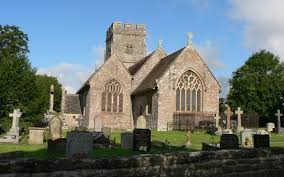
The Church of St Hilary of Poitiers
St. Hilary Church is a Grade II listed Anglican church dating back to the 14th century. It is a substantial structure in the later English style, consisting of a nave, south aisle, and chancel, with a 16th-century embattled tower at the west end. The nave is 45 feet (14 m) long and 33 feet (10 m) broad including the aisle. The chancel 22 feet (6.7 m) long and 15 feet (4.6 m) wide and the arch dates further back to the twelfth century, evidently from the earlier building which was situated on the site. The eastern window of the south aisle and that of the chancel is ornamented with stained glass, representing the arms of the Traherne family. The Bassett Family Tomb Enclosure is listed as a Grade II building. In the chancel is a recumbent figure, in armour, with a Latin inscription, to the memory of Thomas Bassett of Old Beau Pre, who died in 1423. In the south aisle, there is a tablet to the memory of the late Mrs. Traherne, who died in 1796, and to that of her sister, Anna Maria Edmondes.
The church was restored in 1861–2 "at the expense of Mrs Charlotte Traherne of Coedriglan" under the designs of the architect Sir George Gilbert Scott and Reverend John Montgomery Traherne.
Cardiff Times (2 May 1862) reported the following:
"The old church at this place, which was in a very delapidated condition, has been restored at the sole cost of Mrs. Montgomery Treherne, as a memorial of her late husband, the Rev. John Montgomery Traherne. George Gilbert Scott, Esq., of London, is the architect who has superintended the restoration, and Messrs. James and Price, of Cardiff, have executed the work. This ancient building, which was erected in the decorated and perpendicular style of architecture, has been restored with faithful adherence to its original condition, and a fine Norman arch, which was hidden from the view by white-wash, &c., has been brought to view and forms a most pleasing feature in the restoration. The entire work has cost about £2,000, which has been borne by this lady who has now the satisfaction for seeing completed a worthy memorial of one who was held in great estimation while living. The church was reopened on Friday last, when the Bishop and other dignitaries were present, and the Rev. C. F. B. Wood, of Penmark, preached in the morning, and the Yen. Archdeacon Blosse in afternoon. After the morning sermon a collection was taken, amounting to £ 35, on behalf of the African Central Missionary Society, an institution in which the late Mr. Treherne took great interest."
In the Weekly Mail (26 May 1900) it was reported that t"he Lord Bishop of Llandaff, on Saturday, visited the parish of St Hilary for the purpose of dedicating the handsome new Lych-Gate which has recently been erected in the church yard by the late Mrs Traherne in memory of her husband the late Mr G.M Traherne of Coedriglnn Park, formerly of St Hilary. A procession of the bishop and clergy entered the church at four pm and evensong was said by the rector after which the clergy and the congregation proceeded to the churchyard, and the bishop gave a short address explaining the object of the service. The dedicatory prayers were then offered and the interesting ceremony concluded with a hymn and the episcopal benediction. A large number of clergy and others attended the service, and the visitors were afterwards entertained to tea."
Tower and bells
The church tower contains a ring of six bells, consisting of Rudhall bells dating from 1742, which were recast into a ring of five by Taylors of Loughborough in 1906. As a community project to mark the beginning of the third Christian Millennium, Taylors added a treble, which was dedicated by the Archbishop of Wales on 20 March 1999.
Here's the link to St Hilary 2000 celebrations which includes details about the dedication of the bell.
Ringing at the local churches is arranged by a Parish band, which moves around all three churches for practice nights, and for Sunday service ringing. A Parish Ringing Master, who works in co-operation with three Local Tower Captains, directs the ringing. In addition, the Parish possesses a set of 17 chromatic handbells.
Caroline, the daughter of Edith and Ken Vaughan told us that her father joined the St Hilary church bell ringing team on arriving in the village (1950) and eventually took over the running of the team when Mr Lassiter retired. He continued for about 20 years. A that time they rang the bells every Sunday: “Our vicar was Mr Crockatt. He lived where Mr & Mrs Colin Shaw now live. He had a daughter Muriel; she was a lovely lady. They had an orchard just below the vicarage where the children would ‘scrump’ the apples. The vicar would often catch us and in church the following Sunday he would point at us when saying the commandment ‘thou shalt not steal’ which terrified us”. Caroline's story.
The tomb that tells two stories
Here is a link to a video by Graham Loveluck-Edwards about why the 14th Century tomb of Sir Thomas Basset was vandalised in the 17th Century and how his grave in St Hilary Church became a monument to two very turbulent periods of history.
Plaques in the Church
WW1 Casualties
George Rees Died 27 August 1918 Reg No. 56701 13th Battalion Welsh Regiment
George Rees was the son of John Rees of Llanmaes and Catherine Williams of St. Hillary. John and Catherine were married at St Hilary on 16 April 1885; John was a mason, as was his father before him and Catherine was a domestic servant. George was one of 5 children, 4 boys and 1 girl. He was born in St Hilary in early 1892 and Baptised there on 6 March 1892.
The family lived at Rectory Lodge at the time of the 1901 census and probably at the Post Office St Hilary at the time of the 1911 census. By this time Catherine was Assistant Postmaster and George was working as a gardener.
George enlisted in the army in Cardiff on 1September 1915 in the 7th (Cyclist) Battalion of the Welsh Regiment. He was later transferred to the 10th Welsh Regiment and embarked at Southampton for France on 26 July 1916, disembarking at Rouen the following day. He was promoted to L/Corporal on 21st July 1916, to Corporal on 11 May 1917, made acting Sergeant on 3 August 1917 and promoted to Sergeant on 17 October 1917. He was with the 10th Battalion when he was promoted to Sergeant but was posted to 13th Battalion. Shortly afterwards.
He was killed in action on 27 August 1918 and is buried in the Guards Cemetery at Lesboeufs, Somme, France.
He was awarded, posthumously, the British War Medal and the Victory Medal.
At the time he died his parents were still living at the Post Office in St Hilary with his sister Annie, and one of his brothers David was living at Aubrey Terrace in Cowbridge.
Hugh Thomas Ackland-Allen Died 23 October 1914 1st Battalion (23rd Foot) The Royal Welsh Fusiliers
Hugh was born in Plymouth, Devon on 17 September 1893. His parents were Captain Charles Ackland-Allen JP from Tenby, Pembrokeshire and Gertrude Elizabeth Ackland-Allen (nee Bearcroft) from Hanbury, Worcestershire. He was the second of two sons and two daughters, his brother Thomas dying when only 3 days old.
At the time of the 1901census the family were living at The Cross, St Hilary. Although living in St Hilary in 1911 the actual address of the family residence is uncertain. The were however living at St Hilary Manor at the time Hugh died and continued in residence there at least until the time his father passed away in 1934.
Hugh was educated at Wellington College, Berkshire and the Royal Military College, Sandhurst; and was gazetted 2nd Lieutenant Royal Welsh Fusiliers on 3 September 1913. He went to Malta with his regiment in January 1914 and returned to England in the September that year. He served with the British Expeditionary Force in France and Flanders from 4 October 1914. He was killed in action near Zonnebeke, West-Vlaanderen, Belgium on 23 October 1914. He was only 21 years old. He is commemorated at the Ypres, Menin Gate Memorial.
Hugh was awarded, posthumously, the British War Medal and the Victory Medal, and the 1914/5 Star.
A memorial plaque on the lych gate commemorates parishioners who returned from the First World war - here are more details about the village and WWI which includes photographs of memorials to the men who died.
Daniel Jones (1754-1851) Benefactor Cardiff Royal Infirmary
There is a plaque commemorating Daniel Jones in the church. He was a resident of St Hilary residing in New Beaupre, St Hilary.
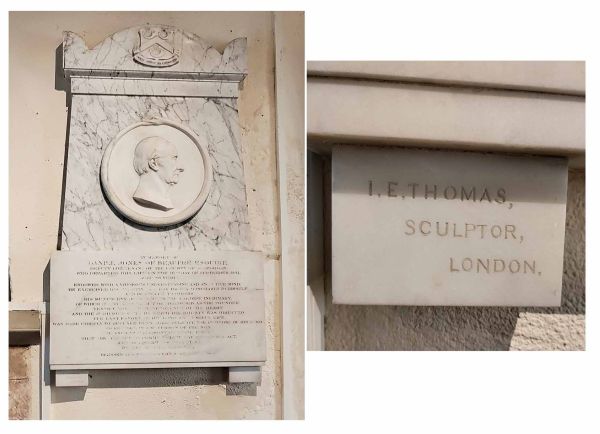
The inscription on the plaque reads as follows:
“In memory of DANIEL JONES of Beaupre Esquire Deputy Lieutenant of the County of Glamorgan who departed this life on the 19th day of September 1841 aged 88 years. Endowed with a vigorous understanding and an active mind he exercised his talents in a way highly honourable to himself and beneficial to others. His munificent donations to the Cardiff Infirmary of which institution he may be regarded as the founder testify both the benevolence of his heart and the judicious care by which his bounty was directed. The last effort of his long and useful life was made chiefly to declare to an aged relative the purpose of his mind to restore in the person of the son the ancient patrimony of their family. That son desired to commemorate the generous act and to record his gratitude by this humble memorial. Blessed are the dead which die in the Lord.” (PM-742.5)
The plaque was sculpted by John Evans Thomas
_____________________________________________
We are grateful to William Gibbs, Brecknock who emailed the following information in September 2025
“Around the head in profile notice the Oroboros, the snake swallowing its tail, which is an ancient symbol of rebirth and eternity. This is a favourite motif of John Evans Thomas and appears on several of his memorials (Holford at Llansantffraed and Alfred Holfray at Tredegar).
As is usual with his memorials the artist signs himself I.E.Thomas using the Latinised form of his first name (John ; Iohannes).
Sometimes he puts Brecon rather than London. Brecon was where he was born but his studio was in Lower Belgrave Terrace in London.
Thomas loved carving heraldic forms and here he has carved a crest at the top of the memorial with three hunting horns with a pair of Compasses above each and a dividing Chevron. I can find no coat of arms like this online. The Welsh motto reads “Gwell angau na chywilydd” which translates as ‘Better Death than dishonour’
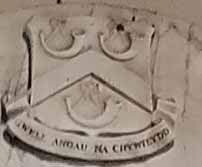
However, in the ruins of Beaupre Castle there are the remains of the family coat of Arms which bears similar words “Gwell anghay na chywilydd” but what seems to be a misspelling of “angau” as “anghay”.

And on the Coat of Arms in the outer wall (1586) are three Hunting Horns and Compasses in the top lefthand quadrant. This matches Thomas’ design on the church memorial.
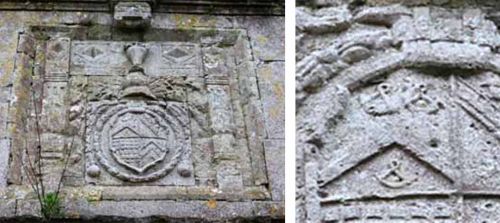
John Evans Thomas had sculpted Daniel Jones in his lifetime, having been commissioned to carve his bust for the Cardiff Infirmary which he had generously endowed. This bust now stands in the entrance hallway to the National Museum of Wales”.
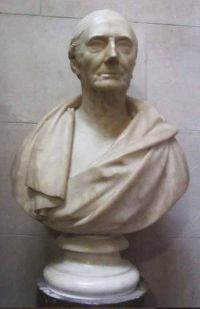
_____________________________________________
